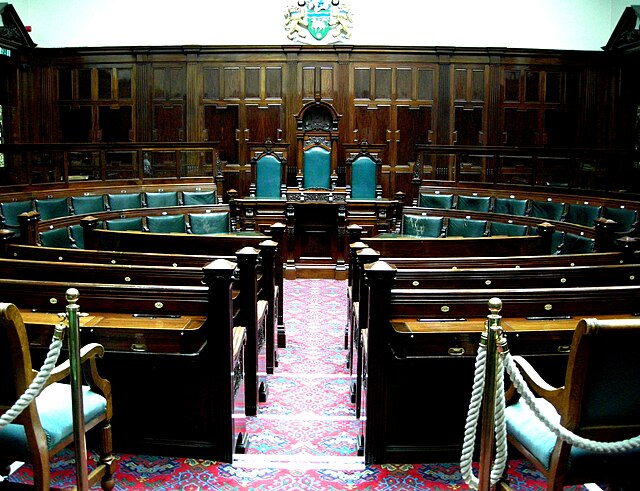A committee or commission is a body of one or more persons subordinate to a deliberative assembly. A committee is not itself considered to be a form of assembly. Usually, the assembly sends matters into a committee as a way to explore them more fully than would be possible if the assembly itself were considering them. Committees may have different functions and their types of work differ depending on the type of the organization and its needs.
Committee room, designed in 1901, in Halifax Town Hall
Meeting of the Constitutional Law Committee of the Finnish Parliament [fi] (Finnish: Perustuslakivaliokunta) at the House of the Estates in Helsinki, Finland in 1918. The chairman of the committee, K. J. Ståhlberg, at the left end of the table with his back to the camera.
Joint meeting of two Sejm committees, the Social Policy and Family Committee, and the Education, Science and Youth Committee, in the Sejm complex in 2018.
Robert's Rules of Order, often simply referred to as Robert's Rules, is a manual of parliamentary procedure by U.S. Army officer Henry Martyn Robert. "The object of Rules of Order is to assist an assembly to accomplish the work for which it was designed [...] Where there is no law [...] there is the least of real liberty." The term Robert's Rules of Order is also used more generically to refer to any of the more recent editions, by various editors and authors, based on any of Robert's original editions, and the term is used more generically in the United States to refer to parliamentary procedure. It was written primarily to help guide voluntary associations in their operations of governance.
Cover of 2020 (3rd) edition
Cover of 2020 (12th) edition
First edition, 1876
Henry M. Robert


![Meeting of the Constitutional Law Committee of the Finnish Parliament [fi] (Finnish: Perustuslakivaliokunta) at the House of the Estates in Helsinki,](https://upload.wikimedia.org/wikipedia/commons/thumb/b/bf/Perustuslakivaliokunta_1918.jpg/640px-Perustuslakivaliokunta_1918.jpg)




